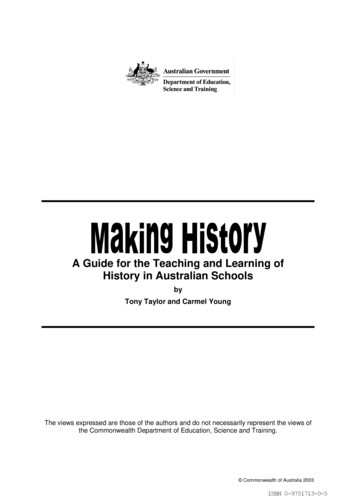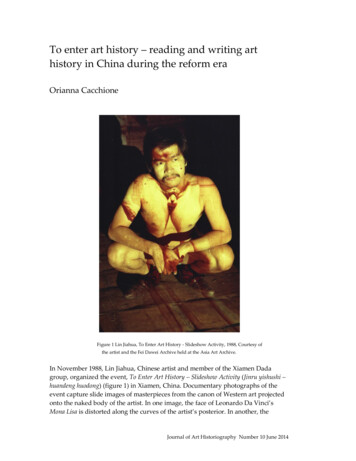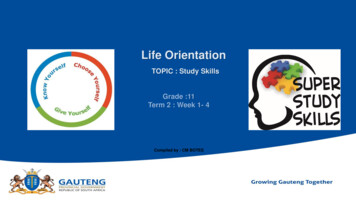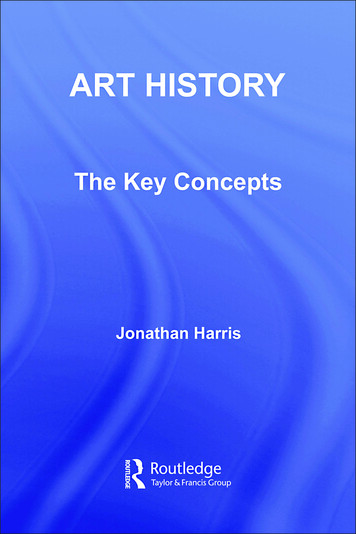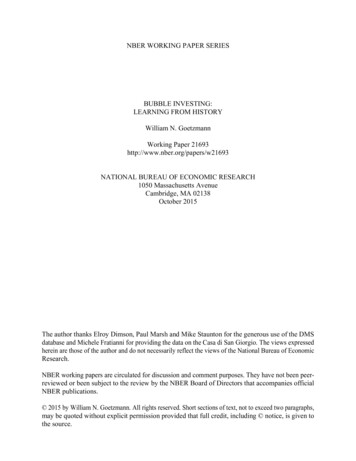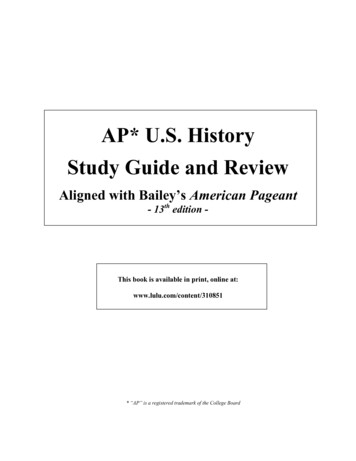
Transcription
AP* U.S. HistoryStudy Guide and ReviewAligned with Bailey’s American Pageant- 13th edition -This book is available in print, online at:www.lulu.com/content/310851* “AP” is a registered trademark of the College Board
AP US History Review and Study Guide for “American Pageant” is available in print at www.lulu.com/content/310851Notes Don’t use this review instead of reading the text. Use this as a supplement, not a substitute. Be sure to practice free-response questions as well as studying the facts in this review. Be sure to practice essays and DBQ’s.Sources The American Pageant, 13th edition, by Kennedy, Cohen, and Bailey http://www.hostultra.com/ apusnotes served as a resource for the outlines. http://www.course-notes.org served as a resource for the vocabulary.2
AP US History Review and Study Guide for “American Pageant” is available in print at www.lulu.com/content/310851Chapter 1New World BeginningsI.The Shaping of North Americai. Recorded history began 6,000 years ago. It was 500 years ago that Europeans set foot on theAmericas to begin colonizationii. The theory of “Pangaea” exists suggesting that the continents were once nestled together intoone mega-continent. They then spread out as drifting islands.iii. Geologic forces of continental plates created the Appalachian and Rocky Mountains.iv. The Great Ice Age thrust down over North America & scoured the present day AmericanMidwest.II. Peopling the Americasi. “Land Bridge”1. As the Great Ice Age diminished, so did the glaciers over North America.2. The theory holds that a “Land Bridge” emerged linking Asia & North America acrosswhat’s today the Bering Sea. People were said to have walked across the “bridge”before the sea level rose and sealed it off and thus populated the Americas.3. The Land Bridge is suggested as occurring an estimated 35,000 years ago.ii. Many peoples1. Those groups that traversed the bridge spread across North, Central, and SouthAmerica.2. Countless tribes emerged with an estimated 2,000 languages. Notably i. Incas – Peru, with elaborate network of roads and bridges linkingtheir empire.ii. Mayas – Yucatan Peninsula, with their step pyramids.iii. Aztecs – Mexico, with step pyramids and huge sacrifices ofconquered peoples.III. The Earliest Americansi. Development of corn or “maize” around 5,000 B.C. in Mexico was revolutionary in that 1. Then, people didn’t have to be hunter-gatherers, they could settle down and be farmers.2. This fact gave rise to towns and then cities.3. Corn arrived in the present day U.S. around 1,200 B.C.ii. Pueblo Indians1. The Pueblos were the 1st American corn growers.2. They lived in adobe houses (dried mud) and pueblos (“villages” in Spanish). Pueblosare villages of cubicle shaped adobe houses, stacked one on top the other and oftenbeneath cliffs.3. They had elaborate irrigation systems to draw water away from rivers to grown corn.iii. Mound Builders1. These people built huge ceremonial and burial mounds and were located in the OhioValley.2. Cahokia, near East St. Louis today, held 40,000 people.iv. Eastern Indians1. Eastern Indians grew corn, beans, and squash in “three sister” farming a. Corn grew in a stalk providing a trellis for beans, beans grew up the stalk,squash’s broad leaves kept the sun off the ground and thus kept the moisturein the soil.b. This group likely had the best (most diverse) diet of all North AmericanIndians and is typified by the Cherokee, Creek, Choctaw (South) andIroquois (North).v. Iroquois Confederation1. Hiawatha was the legendary leader of the group.2. The Iroquois Confederation was a group of 5 tribes in New York state.3. They were matrilineal as authority and possessions passed down through the femaleline.4. Each tribe kept their independence, but met occasionally to discuss matters of commoninterest, like war/defense.3
AP US History Review and Study Guide for “American Pageant” is available in print at www.lulu.com/content/3108515. This was not the norm. Usually, Indians were scattered and separated (and thus weak).vi. Native Americans had a very different view of things as compared to Europeans.1. Native Americans felt no man owned the land, the tribe did. (Europeans liked privateproperty)2. Indians felt nature was mixed with many spirits. (Europeans were Christian andmonotheistic)3. Indians had little or no concept or interest in money. (Europeans loved money or gold)IV. Indirect Discoverers of the New Worldi. The 1st Europeans to come to America were the Norse (Vikings from Norway).1. Around 1000 AD, the Vikings landed, led by Erik the Red and Leif Erikson.2. They landed in “Newfoundland” or “Vinland” (because of all the vines).3. However, these men left America and left no written record and therefore didn’t get thecredit.4. The only record is found in Viking sagas or songs.ii. The Christian Crusaders of Middle Ages fought in Palestine to regain the Holy Land fromMuslims. This mixing of East and West created a sweet-tooth where Europeans wanted thespices of the exotic East.V. Europeans Enter Africai. Marco Polo traveled to China and stirred up a storm of European interest.ii. Mixed with desire for spices, an East to West (Asia to Europe) trade flourished but had to beoverland, at least in part. This initiated new exploration down around Africa in hopes of aneasier (all water) route.iii. Portugal literally started a sailing school to find better ways to get to the “Spice Islands,”eventually rounding Africa’s southern Cape of Good Hope.iv. New developments 1. caravel – a ship with triangular sail that could better tack (zig-zag) ahead into the windand thus return to Europe from Africa coast.2. compass – to determine direction.3. astrolabe – a sextant gizmo that could tell a ship’s latitude.v. Slave trade begins1. The 1st slave trade was across the Sahara Desert.2. Later, it was along the West African coast. Slave traders purposely busted up tribes andfamilies in order to squelch any possible uprising.3. Slaves wound up on sugar plantations the Portuguese had set up on the tropical islandsoff Africa’s coast.4. Spain watched Portugal’s success with exploration and slaving and wanted a piece ofthe pie.VI. Columbus Comes upon a New Worldi. Columbus convinced Isabella and Ferdinand to fund his expedition.ii. His goal was to reach the East (East Indies) by sailing west, thus bypassing the around-Africaroute that Portugal monopolized.iii. He misjudged the size of the Earth though, thinking it 1/3 the size of what it was.iv. So, after 30 days or so at sea, when he struck land, he assumed he’d made it to the East Indiesand therefore mistook the people as “Indians.”v. This spawned the following system a. Europe would provide the market, capital, technology.b. Africa would provide the labor.c. The New World would provide the raw materials (gold, soil, lumber).VII. When Worlds Collidei. Of huge importance was the biological flip-flop of Old and New Worlds. Simply put, we tradedlife such as plants, foods, animals, germs.ii. From the New World (America) to the Old1. corn, potatoes, tobacco, beans, peppers, manioc, pumpkin, squash, tomato, wild rice,etc.2. also, syphilisiii. From Old World to the New1. cows, pigs, horses, wheat, sugar cane, apples, cabbage, citrus, carrots, Kentuckybluegrass, etc.2. devastating diseases – smallpox, yellow fever, malaria as Indians had no immunities.a. The Indians had no immunities in their systems built up over generations.4
AP US History Review and Study Guide for “American Pageant” is available in print at www.lulu.com/content/310851b. An estimated 90% of all pre-Columbus Indians died, mostly due to disease.The Spanish Conquistadoresi. Treaty of Tordesillas 1494 – Portugal and Spain feuded over who got what land. The Popedrew this line as he was respected by both.1. The line ran North-South, and chopped off the Brazilian coast of South America2. Portugal – got everything east of the line (Brazil and land around/under Africa)3. Spain – got everything west of the line (which turned out to be much more, though theydidn’t know it at the time)ii. Conquistadores “conquerors”1. Vasco Balboa – “discovered” the Pacific Ocean across isthmus of Panama2. Ferdinand Magellan – circumnavigates the globe (1st to do so)3. Ponce de Leon – touches and names Florida looking for legendary “Fountain ofYouth”4. Hernando Cortes – enters Florida, travels up into present day Southeastern U.S., diesand is “buried” in Mississippi River5. Francisco Pizarro – conquers Incan Empire of Peru and begins shipping tons ofgold/silver back to Spain. This huge influx of precious metals made European pricesskyrocket (inflation).6. Francisco Coronado – ventured into current Southwest U.S. looking for legendary ElDorado, city of gold. He found the Pueblo Indians.iii. Encomienda system established1. Indians were “commended” or given to Spanish landlords2. The idea of the encomienda was that Indians would work and be converted toChristianity, but it was basically just slavery on a sugar plantation guised as missionarywork.IX. The Conquest of Mexicoi. Hernando Cortez conquered the Aztecs at Tenochtitlan.ii. Cortez went from Cuba to present day Vera Cruz, then marched over mountains to the Azteccapital.iii. Montezuma, Aztec king, thought Cortez might be the god Quetzalcoatl who was due to reappear the very year. Montezuma welcomed Cortez into Tenochtitlan.iv. The Spanish lust for gold led Montezuma to attack on the noche triste, sad night. Cortez andmen fought their way out, but it was smallpox that eventually beat the Indians.v. The Spanish then destroyed Tenochtitlan, building the Spanish capital (Mexico City) exactly ontop of the Aztec city.vi. A new race of people emerged, mestizos, a mix of Spanish and Indian blood.X. The Spread of Spanish Americai. Spanish society quickly spread through Peru and Mexicoii. A threat came from neighbors 1. English – John Cabot (an Italian who sailed for England) touched the coast of thecurrent day U.S.2. Italy – Giovanni de Verrazano also touched on the North American seaboard.3. France – Jacques Cartier went into mouth of St. Lawrence River (Canada).iii. To oppose this, Spain set up forts (presidios) all over the California coast. Also cities, like St.Augustine in Florida.iv. Don Juan de Onate followed Coronado’s old path into present day New Mexico. He conqueredthe Indians ruthlessly, maiming them by cutting off one foot of survivors just so they’dremember.v. Despite mission efforts, the Pueblo Indians revolted in Pope’s Rebellion.vi. Robert de LaSalle sailed down the Mississippi River for France claiming the whole region fortheir King Louis and naming the area “Louisiana” after his king. This started a slew of placenames for that area, from LaSalle, Illinois to “Louisville” and then on down to New Orleans (theAmerican counter of Joan of Arc’s famous victory at Orleans).vii. “Black Legend” – The Black Legend was the notion that Spaniards only brought bad things(murder, disease, slavery); though true, they also brought good things such as law systems,architecture, Christianity, language, civilization, so that the Black Legend is partly, but notentirely, accurate.VIII.5
AP US History Review and Study Guide for “American Pageant” is available in print at www.lulu.com/content/310851Chapter 1 VocabularyMarco Polo - Italian explorer who spent many years in China or near it. His return to Europe in 1295 sparked a Europeaninterest in finding a quicker route to Asia.Francisco Pizarro - New World conqueror or Spanish conquistador who crushed the Incan civilization in Peru, took their goldand silver, and enslaved the Incas in 1532.Ponce de León - Spanish explorer who sailed to the New World in 1513 and in 1521. He explored Florida, thinking it was anisland, while looking for gold and the perhaps the fabled "fountain of youth." He failed in his search for the fountain of youthbut established Florida as territory for the Spanish, before being killed by a Native American arrow.Hernando de Soto – A Spanish conquistador. He explored in 1540's from Florida west to the Mississippi with six hundred menin search of gold. He discovered the Mississippi River, before being killed by Indians and buried in the river.Montezuma - Aztec chieftain who encountered Cortes and the Spanish and seeing that they rode horses, Montezuma assumedthat the Spanish were gods. He welcomed them hospitably, but the explorers soon turned on the natives, crushed them, andruled them for three centuries.Christopher Columbus - An Italian navigator who was funded by the Spanish government to find a passage to the Far East.He is given credit for discovering the "New World," even though at his death he believed he had made it to India. He made fourvoyages to the "New World." The first sighting of land was on October 12, 1492, and three other journeys until the time of hisdeath in 1503.Treaty of Tordesillas - In 1494, Spain and Portugal were disputing the lands of the New World, so the Spanish went to thePope, and he divided the land of South America for them. Spain got the vast majority, the west, and Portugal got the east.Mestizos - The mestizos were the mixed race of people created when the Spanish intermarried with the surviving Indians inMexico.Renaissance - After the Middle Ages there was a rebirth of culture in Europe where art and science were developed. It wasduring this time of enrichment that America was discovered.Canadian Shield – The geological shape of North America estimated at 10 million years ago. It held the northeast corner ofNorth America in place and was the first part of North America theorized to come above sea levelMound Builders - The mound builders of the Ohio River Valley and the Mississippian culture of the lower Midwest didsustain some large settlements after the incorporation of corn planting into their way of life during the first millennium A.D.The Mississippian settlement at Cahokia, near present-day East St. Louis, Ill., was perhaps home to 40,000 people in about A.D1100. But mysteriously, around the year 1,300, both the Mound Builder and the Mississippian cultures had fallen to decline.Spanish Armada - "Invincible" group of ships sent by King Philip II of Spain to invade England in 1588. The Armada wasdefeated by smaller, more maneuverable English "sea dogs" in the English Channel. This event marked the beginning ofEnglish naval dominance and fall of Spanish dominance."black legend" - The idea developed during North American colonial times that the Spanish utterly destroyed the Indiansthrough slavery and disease and left nothing of value. In truth, there was good along with the bad (architecture, religion,government, etc.)Conquistadores - Spanish explorers that invaded Central and South America for its riches during the 1500s. In doing so, theyconquered the Incas, Aztecs, and other Native Americans of the area. Eventually, they intermarried with these tribes.Aztecs - The Aztecs were a powerful Native American empire who lived in Mexico. Their capital was Tenochtitlan. Theyworshipped everything around them, especially the sun. Cortes conquered them in 1521.Pueblo Indians - The Pueblo Indians lived in the Southwestern United States. They built extensive irrigation systems to watertheir primary crop, which was corn. Their houses were multi-storied buildings made of adobe (dried mud).Joint stock companies - These were developed to gather the savings from the middle class to support finance colonies.Examples were the London Company and Plymouth Company. They’re the forerunner of modern day corporations.Hiawatha - He was legendary leader who inspired the Iroquois, a powerful group of Native Americans in the northeasterwoodlands of the U.S.Vasco Nuñez Balboa – European discoverer of the Pacific Ocean in 1513.Ferdinand Magellan - In 1519, his crew began a voyage and eventually ended up becoming the first to circumnavigate theworld, even though he died in the Philippines. The sole surviving ship returned to Europe in 1522.Francisco Coronado - From 1540 to 1542, he explored the pueblos of Arizona and New Mexico looking for the legendary cityof gold El Dorado, penetrating as far east as Kansas. He also discovered the Grand Canyon and enormous herds of bison.Hernando de Soto - From 1539 to 1542, he explored Florida and crossed the Mississippi River. He brutally abused Indiansand died of fever and battle wounds.Francisco Pizarro - In 1532, he crushed the Incas of Peru and obtained loads of bounty in gold and silver.Encomienda system -- Plantation systems where Indians were essentially enslaved under the disguise of being converted toChristianity.Bartolomé de Las Casas - A Spanish missionary who was appalled by the method of encomienda systems, calling it “a moralpestilence invented by Satan.”Hernándo Cortés - Annihilator of the Aztecs in 1519.6
AP US History Review and Study Guide for “American Pageant” is available in print at www.lulu.com/content/310851Malinche - A female Indian slave who became Cortes’ translator.John Cabot - AKA Giovanni Caboto, Italian who explored the northeastern coast of North America for England in 1497-98.Giovanni da Verranzo - Another Italian explorer, he was dispatched by the French king in 1524 to probe the eastern seaboardof what is today’s U.S.Don Juan de Oñate - Leader of a Spanish group that ranged parts of Mexico, Arizona, New Mexico, and Texas in 1598. Hebrutally crushed the Pueblo Indians he met and proclaimed the province of New Mexico in 1609. He also founded its capital,Santa Fe.Robert de La Salle - Sent by the French, he went on an expedition through the Great Lakes and down the Mississippi in the1680s.Chapter 2The Planting of English AmericaI.England’s Imperial Stirringsi. North America in 1600 was largely unclaimed, though the Spanish had much control in Central andSouth America.ii. Spain had only set up Santa Fe, while France had founded Quebec and Britain had foundedJamestown.iii. In the 1500s, Britain failed to effectively colonize due to internal conflicts.1. King Henry VIII broke with the Roman Catholic Church in the 1530s and launched theEnglish Protestant Reformation.2. After Elizabeth I became queen, Britain became basically Protestant, and a rivalry withCatholic Spain intensified.3. In Ireland, the Catholics sought Spain’s help in revolting against England, but the Englishcrushed the uprising with brutal atrocity, and developed an attitude of sneering contempt fornatives.II. Elizabeth Energizes Englandi. After Francis Drake pirated Spanish ships for gold then circumnavigated the globe, Elizabeth Iknighted him on his ship. Obviously, this reward angered the Spanish who sought revenge.ii. Meanwhile, English attempts at colonization in the New World failed embarrassingly. Notable ofthese failures was Sir Walter Raleigh and the Roanoke Island Colony, better known as “The LostColony.”iii. Seeking to get their revenge, Spain attacked Britain but lost in the Spanish Armada’s defeat of1588. This opened the door for Britain to cross the Atlantic. They swarmed to America and tookover the lead in colonization and power.1. Victory also fueled England to new heights due to a. Strong government/popular monarch, more religious unity, a sense of nationalismb. Golden age of literature (Shakespeare)c. Beginning of British dominance at sea (which lasts until U.S. tops them, around1900)iv. Britain and Spain finally signed a peace treaty in 1604.III. England on the Eve of the Empirei. In the 1500s, Britain’s population was mushrooming.ii. New policy of enclosure (fencing in land) for farming. This meant there was less or no land for thepoor.iii. The woolen districts fell upon hard times economically. This meant the workers lost jobs.iv. Tradition of primogeniture 1st born son inherits ALL father’s land. Therefore, younger sons ofrich folk (who couldn’t inherit money) tried their luck with fortunes elsewhere, like America.v. By the 1600s, the joint-stock company was perfected (investors put money into the company withhopes for a good return), being a forerunner of today’s corporations.IV. England Plants the Jamestown Seedlingi. In 1606, the Virginia Company received a charter from King James I to make a settlement in theNew World.7
AP US History Review and Study Guide for “American Pageant” is available in print at www.lulu.com/content/3108511.Such joint-stock companies usually did not exist long, as stockholders invested hopes toform the company, turn a profit, and then quickly sell for profit a few years later.ii. The charter of the Virginia Company guaranteed settlers the same rights as Englishmen in Britain.iii. On May 24, 1607, about 100 English settlers disembarked from their ship and founded Jamestown.1. Forty colonists had perished during the voyage.2. Problems emerged including (a) the swampy site of Jamestown meant poor drinking waterand mosquitoes causing malaria and yellow fever. (b) men wasted time looking for goldrather than doing useful tasks (digging wells, building shelter, planting crops), (c) therewere zero women on the initial ship.3. It didn’t help that a supply ship shipwrecked in the Bahamas in 1609 either.iv. Luckily, in 1608, a Captain John Smith took over control and whipped the colonists into shape.1. At one point, he was kidnapped by local Indians and forced into a mock execution by thechief Powhatan and had been “saved” by Powhatan’s daughter, Pocahontas.2. The act was meant to show that Powhatan wanted peaceful relations with the colonists.3. John Smith’s main contribution was that he gave order and discipline, highlighted by his“no work, no food” policy.v. Colonists had to eat cats, dogs, rats, even other people. One fellow wrote of eating “powderedwife.”vi. Finally, in 1610, a relief party headed by Lord De La Warr arrived to alleviate the suffering.vii. By 1625, out of an original overall total of 8,000 would-be settlers, only 1,200 had survived.V. Cultural Clash in the Chesapeakei. At first, Powhatan possibly considered the new colonists potential allies and tried to be friendly withthem, but as time passed and colonists raided Indian food supplies, relations deteriorated andeventually, war occurred.ii. The First Anglo-Powhatan War ended in 1614 with a peace settlement sealed by the marriage ofPocahontas to colonist John Rolfe. Rolfe & Pocahontas nurtured a favorable flavor of sweettobacco.iii. Eight years later, in 1622, the Indians struck again with a series of attacks that left 347 settlers,including John Rolfe, dead.iv. The Second Anglo-Powhatan War began in 1644, ended in 1646, and effectively banished theChesapeake Indians from their ancestral lands.v. After the settlers began to grow their own food, the Indians were useless, and were thereforebanished.VI. The Indians’ New Worldi. The arrival of Europeans set a series of vast changes into motion for the Native Americans.1. Horses were brought by the Spaniards to transform Indian lifestyles—especially the Siouxwho’d become expert at buffalo hunting while horseback.2. Disease was the largest change to come to the New World.a. Indians were biological pathogens to fight white diseases.b. Tribes were shattered; for example, the Catawba nation emerged in the Carolinapiedmont as remnants of broken tribes from all along the east coast.3. Native Americans lusted for firearms, obtained them, and violence increased against whitesand other Indians.ii. All told, European arrival rocked the institutions of Indian life and sent their lives reeling.VII. Virginia: Child of Tobaccoi. Jamestown’s gold is found tobacco1. Rolfe’s sweet tobacco was sought as a cash crop by Europe. Jamestown had found its gold.2. Tobacco created a greed for land, since it heavily depleted the soil and ruined the land.ii. Representative self-government was born in Virginia, when in 1619, settlers created the House ofBurgesses, a committee to work out local issues. This set America on a self-rule pathway.iii. The first African Americans to arrive in America also came in 1619. It’s unclear if they were slavesor indentured servants.VIII.Maryland: Catholic Haveni. Religious Diversity1. Founded in 1634 by Lord Baltimore, Maryland was the second plantation colony and thefourth overall colony to be formed.2. It was founded to be a place for persecuted Catholics to find refuge, a safe haven.3. Lord Baltimore gave huge estates to his Catholic relatives, but the poorer people whosettled there where mostly Protestant, creating friction.ii. However, Maryland prospered with tobacco.8
AP US History Review and Study Guide for “American Pageant” is available in print at www.lulu.com/content/310851iii. It had a lot of indentured servants.1. Only in the later years of the 1600s (in Maryland and Virginia) did Black slavery begin tobecome popular.iv. Maryland’s statute, the Act of Toleration, guaranteed religious toleration to all Christians, butdecreed the death penalty to Jews and atheists and others who didn’t believe in the divinity of JesusChrist.IX. The West Indies: Way Station to Mainland Americai. As the British were colonizing Virginia, they were also settling into the West Indies (Spain’sdeclining power opened the door).ii. By mid-1600s, England had secured claim to several West Indies islands, including Jamaica in 1655.iii. They grew lots of sugar on brutal plantations there.iv. Thousands of African slaves were needed to operate sugar plantations. At first, Indians wereintended to be used, but disease killed an estimated 90% of all Native Americans. So, Africans werebrought in.v. To control so many slaves, “codes” were set up that defined the legal status of slaves and the rightsof the masters. They were typically strict and exacted severe punishments for offenders.X. Colonizing the Carolinasi. In England, King Charles I had been beheaded. Oliver Cromwell had ruled for ten very strict yearsbefore tired Englishmen restored Charles II to the throne in “The Restoration.” (After all theturmoil Civil War, they just went back to a king.)ii. The bloody period had interrupted colonization.iii. Carolina was named after Charles II, and was formally created in 1670.iv. Carolina flourished by developing close economic ties with the West Indies, due to the port ofCharleston.v. Many original Carolina settlers had come from Barbados and brought in the strict “Slave Codes” forruling slaves.vi. Interestingly, Indians as slaves in Carolina was protested, but to no avail. Slaves were sent to theWest Indies to work, as well as New England.vii. Rice emerged as the principle crop in Carolina.1. African slaves were hired to work on rice plantations, due to (a) their resistance to malariaand just as importantly, (b) their familiarity with rice.viii. Despite violence with Spanish and Indians, Carolina proved to be too strong to be wiped out.XI. The Emergence of North Carolinai. Many newcomers to Carolina were “squatters,” people who owned no land, usually down fromVirginia.ii. North Carolinians developed a strong resistance to authority, due to geographic isolation fromneighbors.iii. Two “flavors” of Carolinians developed: (a) aristocratic and wealthier down south aroundCharleston and rice & indigo plantations, and (b) strong-willed and independent-minded up north onsmall tobacco farmsiv. In 1712, North and South Carolina were officially separated.v. In 1711, when Tuscarora Indians attacked North Carolina, the Carolinians responded by crushing theopposition, selling hundreds to slavery and leaving the rest to wander north, eventually becoming theSixth Nation of the Iroquois.XII. Late-Coming Georgia: The Buffer Colonyi. Georgia was intended to be a buffer between the British colonies and the hostile Spanish settlementsin Florida (Spanish, Indians, runaway slaves) and the enemy French in Louisiana.ii. It was founded last, in 1733, by a high-minded group of philanthropists, mainly James Oglethorpe.iii. Named after King George II, it was also meant to be a second chance site for wretched souls in debt.iv. James Oglethorpe, the ablest of the founders and a dynamic soldier-statesman, repelled Spanishattacks.1. He saved “the Charity Colony” by his energetic leadership and by using his own fortune tohelp with the colony.v. All Christians, except Catholics, enjoyed religious toleration, and many missionaries came to try toconvert the Indians.1. John Wesley was one of them, and he later returned to England and founded Methodism.vi. Georgia grew very slowly.XIII.The Plantation Coloniesi. Slavery was found in all the plantation colonies.ii. The growth of cities was often stunted by forests.9
AP US History Review and Study Guide for “American Pageant” is available in print at www.lulu.com/content/310851XIV.iii. The establishment of schools and churches was difficult due to people being spread out.iv. In the South, the crops were tobacco and rice, and some indigo in the tidewater region of SC.v. All the plantation colonies permitted some religious toleration.vi. Confrontations with Native Americans were often.Makers of America: The Iroquoisi. In what is now New York State, the Iroquois League or Confederation was once a great power.ii. They were made up of the Mohawks, the Oneidas, the Onondagas, the Cayugas, and the Senecas.iii. They vied with neighboring Indians and later French, English, and Dutch for supremacy.iv. The longhouse was the building block of Iroquois society.1. Only 25 feet wide, but over 200 feet long, longhouses were typically occupied by a fewblood-related families (on the mother’s side).v. The Mohawks were middlemen with European traders.vi. The Senecas were fur suppliers.vii. The Five Nations of the Iroquois’ rivals, the neighboring Hurons, Eries, and Petuns, werevanquished.viii. Throughout the 1600s and 1700s, the Iroquois allied with the British and French (whichever wasmore beneficial).ix. When the American Revolution broke out, the question of with whom to side was split. Most sidedwith the British, but not all.x. Afterwards, the Iroquois were forced to reservations, which proved to be unbear
AP US History Review and Study Guide for “American Pageant” is available in print at www.lulu.com/content/310



